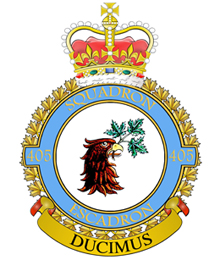| 405 Long Range Patrol Squadron | |
|---|---|
 | |
| Active | April 1941 – September 1945 April 1947–present |
| Country | |
| Branch | |
| Role | Long Range Maritime Patrol |
| Based at | CFB Greenwood, Gransden Lodge Airfield |
| Motto(s) | Ducimus ("We Lead") |
| Battle honours | Fortress Europe 1941–44 France & Germany Biscay Ports 1941–45 Ruhr 1941–45 Berlin 1941 German Ports 1941–45 Normandy 1944 Walcheren Rhine Biscay 1942–43 Arabian Sea [1] Libya [2] |
| Insignia | |
| Squadron Badge heraldry | An eagle's head erased, facing to the sinister and holding in the beak a sprig of maple. |
| Aircraft flown | |
| Bomber | Wellington Halifax Lancaster |
| Patrol | C-45 Expeditor CP-127 (P2V-7) Neptune CP-107 Argus CP-140 Aurora |
405 Long Range Patrol Squadron is a unit of the Royal Canadian Air Force (RCAF) within the Canadian Forces, initially formed as No. 405 Squadron RCAF during the Second World War.


